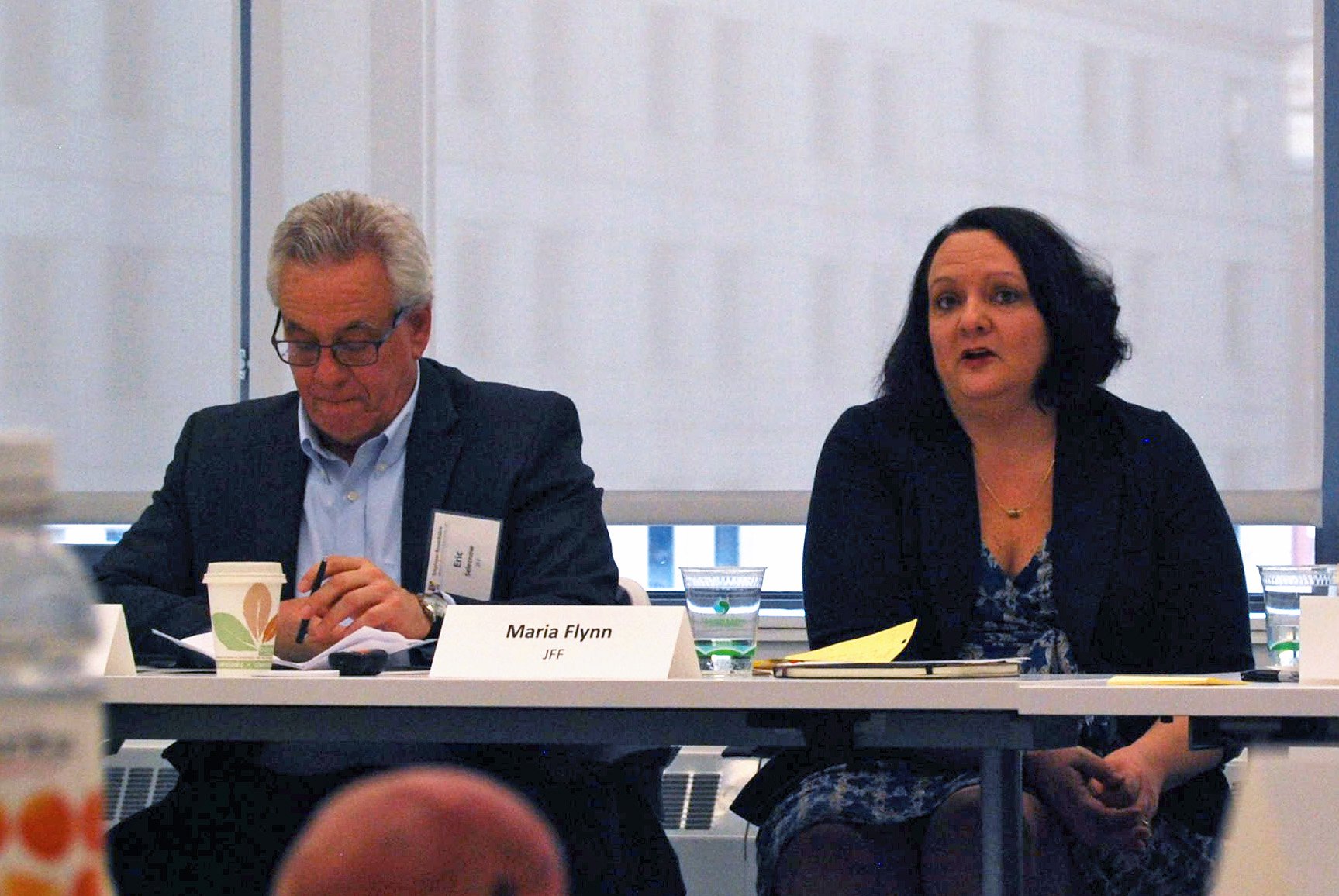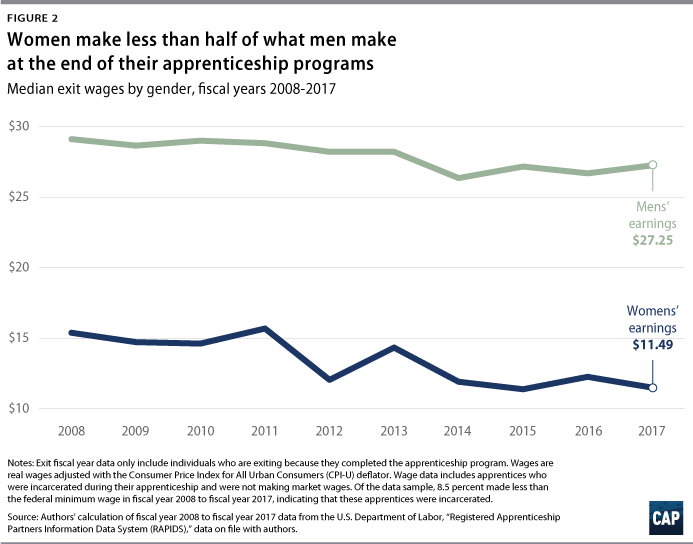
Company Perspectives on Building Equity in Apprenticeships
April 2, 2020
At a Glance
22 companies and industry associations explored what’s working on incorporating equity into their workforce and where further assistance and movement is needed.
At JFF, we have long understood that equity must be an essential component in apprenticeship programs. Last month, we convened representatives from 22 companies and industry associations that share a commitment to diversity and equity in their workforce. We explored what’s working on these issues and where further assistance and movement is needed. We thank the Annie E. Casey Foundation for supporting and hosting this conversation.

Achieving equity in the workforce is imperative to building a strong economy that works for all. While workplace diversity is a topic that has grown in the national conversation, workplace equity is still relatively overlooked. An online search yields only a third of the results for equity in the workplace as for diversity.
Why does this matter? Diversity in the workforce can encompass any number of differences between people, including race, gender, age, ethnicity, religion and many others. Equity means that everyone is treated fairly. While workplace diversity can be thought of as how many different types of people an organization has, equity looks to make sure these differences don’t result in different career outcomes. Are there differences in pay, retention, or promotion that can be seen across different demographics? Pursuing equity helps ensure a level playing field and opens access to previously disenfranchised populations.
This is critical. America has a staggering wealth gap due to racial discrimination and the cumulative effect of earning less over a lifetime. White households in the United States have a median net worth of $127,390. For black households, the median net worth is just $8,050. Without workforce equity, this gap will not close, putting future generations at a disadvantage.
Apprenticeship is a model that can elevate workers into middle-skill careers with good wages. The average hourly wage for a journeyperson who completes an apprenticeship is $23.94, equivalent to an annual salary of $49,795. However, as seen through the workforce more broadly, women and people of color often do not see these positive outcomes. This inequity is due to entry barriers, lack of needed supports, or being considered only for lower-paying occupations.
Women made up only 7.3 percent of apprentices in 2017. What’s more, between 2008 and 2017, men who completed an apprenticeship program earned $27.25 an hour. Women earned $11.49.

Similarly, white apprentices who completed an apprenticeship program earn an average of $26.14 an hour, while black completers earn an average of $14.35.
These numbers must change.
To understand how apprenticeship programs can better support women, people of color, and others who have experienced barriers to access and completion, JFF convened a group of leading manufacturing, health care, and IT companies and industry associations for a candid roundtable. We were greatly encouraged by what we heard: participants were not only willing to engage in this challenging topic, but were energized and excited to go further.
Creating truly equitable apprenticeship programs means providing the supports all potential workers need to obtain a middle-skill job. To remain effective in its promise as a way for people to climb the economic ladder, it’s important that apprenticeship maintains its reputation as an effective workforce development program. “We want apprenticeships to maintain that cachet of being hard to get through,” said a roundtable participant. “We’re paying you, we expect a lot of work from you. These are competitive positions.”
Below are some highlights from the roundtable:
Workforce Equity Is Essential to the Future of Business
“Talent is everything.”
Equity within apprenticeship programs was more than a moral imperative for our participants—it was a business one: “Talent is everything in manufacturing,” said one representative. “[Equity in apprenticeship] will save our industry if we’re successful. It will definitely save our company. We’re building capacity, and that enables us to compete globally.”
In addition to bringing on new talent, more inclusive programs have also led to happier workers throughout companies. “Job satisfaction across the board has increased,” said the participant.
Wraparound Supports, Such as Transportation, Are Key to Equitable Access
“Getting there is the first step to having the opportunity.”
Key to an equitable program are wraparound supports, or systems that can assist workers in overcoming barriers such as transportation, child care, and substance abuse.
One participant noted that work sites may be far from public transportation, an obstacle that can prevent many potential workers from even applying for a job. “Getting there is the first step to having the opportunity,” the participant said.
“As a business, it’s hard to figure out how to pay for wraparound services,” said a health care system representative. “But if you bring people into the apprenticeships [without them], they will fail.”
Wide Representation Brings Wide Applicants
“When you don’t see yourself represented outside of yourself, you feel invisible.”
Many sectors, such as tech and the skilled trades, have to compete against a perception that jobs in those fields are primarily for white men. “When you don’t see yourself represented outside of yourself, you feel invisible,” said a manufacturing representative.
Companies had addressed this challenge by using more diverse imagery in their recruiting and marketing materials and by bringing women and people of color with them while recruiting in-person to speak with potential applicants.
Additionally, businesses are finding that by partnering with local school systems to generate interest in their career paths, they are appealing to a wider set of future workers. “The earlier we start with career awareness, the more diverse we become,” said an attendee.
Contract Requirements Limit Who Can Work
“These success factors start at the top.”
Participants discussed the barriers erected from government contracts, where employees are often required to have a four-year degree. “These success factors start at the top, with requirements for who is eligible for a job,” noted an attendee. “For my workforce, four-year degrees are a barrier to diversity,” said another.
An effective public procurement process that one company experienced was a requirement to have certain percentages of their workers reside in specific counties, zip codes, or be from disadvantaged communities.
Internal Buy-In Takes Multipronged Approaches
“Until you’ve had that ‘I’ve never thought about that’ experience, you won’t relate to it.”
Internal buy-in is key for any organizational change, and infusing equity in apprenticeship programs is no different. Many companies found “diversity dialogues” to be an effective way of building trust, connecting coworkers on a personal and human level, and learning about different experiences.
“As a manager, you have to educate yourself,” said a participant. “Until you have that ‘I’ve never thought about that’ experience, you won’t relate to it.”
A representative from a global pharmaceutical company shared that they held their managers accountable through a stepped infrastructure rollout. First, the company surveyed staff with questions such as “Do you feel you can speak up without retribution?” They then connected these surveys to manager assessments and, ultimately, to executive compensation.
Measuring Success
“If you don’t measure it, you can’t change it.”
One company representative was surprised to learn that an office they thought would outperform all others in terms of achieving equity was far behind. “If you don’t measure it, you can’t change it,” the representative said.
To measure the success of their equity efforts, companies looked beyond the demographic numbers and into performance. “It’s about tenure, did they move up, how long did it take them to move up, where are they moving up,” said an attendee. “This showed us what was working well and what we needed to work on.”
“We looked at every data point—what story is it telling. Not what story are we telling on our website, what story is the data telling.”
—
Our goal at JFF is to support high-quality apprenticeship programs while opening access to people of all races, genders, ages, and abilities. This summer, we will be releasing a report on our findings from this roundtable as well as from dozens of in-depth interviews with companies across the nation in an effort to move this goal forward.
Sign up for our email list to ensure you receive the findings as soon as they are published. With your help, we can start to close the income gap and provide new opportunities and economic advancement for all workers across the nation.